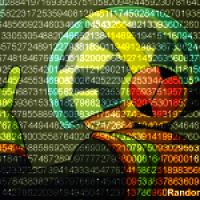The replicators work very well, thank you.
The Technical Manual explanation is not that replicators create matter out of pure energy - they are a type of transporter that dematerializes raw material and rematerializes it to match a molecular pattern. They are “matter-energy converters” only in the sense that the stream of particles during the materialization process could be called an energy stream.
These replicator system headends are located on Deck 12 in the Saucer Module [of the Enterprise-D] and on Deck 34 in the Engineering Section. These systems operate by using a phase-transition coil chamber in which a measured quantity of raw material is dematerialized in a manner similar to that of a standard transporter.
Instead of using a molecular imaging scanner to determine the patterns of the raw stock, however, a quantum geometry transformational matrix field is used to modify the matter stream to conform to a digitally stored molecular pattern matrix. The matter stream is then routed through a network of waveguide conduits that direct the signal to a replicator terminal at which the desired article is materialized within another phase transition chamber.
Was about to cite TNG Tech Manual as well - although that also said that holodeck characters’ bodies were replicated meat puppets, which I think they didn’t stick with.
It thankfully stops short of “meat”:
Such animated characters are composed of solid matter arranged by transporter-based replicators and manipulated by highly articulated computer-driven tractor beams. The results are exceptionally realistic “puppets,” which exhibit behaviors almost exactly like those of living beings, depending on software limits.
Objects created on the Holodeck that are pure holographic images cannot be removed from the Holodeck, even if they appear to possess physical reality because of the focused forcebeam imagery. Objects created by replicator matter conversion do have physical reality and can indeed be removed from the Holodeck, even though they will no longer be under computer control.
Obviously, there is an inconsistency here, as we saw that later holographic characters could not be removed from the holodeck, and therefore must not have been replicated.
Admiral Vance:
“It’s made of our shit, you know?”
apple crunch “Tastes pretty good for shit.”
Well, as noted in that conversation, it wouldn’t work in the real world.
My understanding of canon is that transporter technology does use the energy produced by the warp core to deconstruct matter into energy, then reconstruct it at the desired location.
In that process, a computer has to hold the “pattern” long enough to make the transition possible. Hence pattern buffers.
Replicators use the same method, but have what amounts to better memory, and lower resolution.
A transporter can reconstruct things to such a small scale that every synaptic connection remains intact. Replicators can’t. They are, barring some exceptions that don’t really make sense, unable to produce anything alive.
A replicator cab only produce something it has a “recipe” for. At some point, someone used a transporter or similar device to deconstruct a given thing, like a hot cup of tea. That “pattern”, rather than being held in volatile memory, was recorded. Iirc, in the novels it was Spock that helped refine the technology to be as useful as it would be in TNG, but I haven’t read those in ages.
So, when Picard wants “earl grey, hot”, the replicator pulls up the pattern, uses the energy from a source that isn’t well specified, and turns that energy into matter. Literally every single cup of that tea is going to be the same, within the ability of the replicator to resolve. Since tea isn’t complicated in terms of long chains of molecules, it should be the exact same cup of tea.
However! There were instances I recall seeing of people adjusting replicator files. Tweaking them to their liking.
And, there’s on screen use of big replicators to turn out shuttle parts, as in body pieces.
There’s apparently an upper limit on complexity, which was supposedly about not wanting to make things too easy and make it harder on writers to come up with viable plot points. After all, if you can just replicate entire ships, things get crazy fast. “Oh, the Klingons are invading? Let’s churn out a few dozen extra battle cruisers”
one of latinums things was it can’t be replicated.
That isn’t actually stated anywhere, but…it kind of has to be true in order for latinum to work.
I swear its been stated by characters in ds9
I don’t think so - I’ve never been able to find it.
Had to look this up on Memory Alpha. The base principle for both replicators and transporters is confusingly termed “matter-energy conversion”, yet doesn’t appear to create matter from pure energy. Rather, it seems to use energy to convert matter from/to atomic or subatomic particles (for replicators and transporters, respectively). During the process, the matter is “energized”, and - I’m no expert, but - I’d imagine the subatomic particles in the transporter’s matter stream exhibit energy-like properties.
So replicators do rely on atomic matter stores (often recycled from waste or unnecessary items), and I’d still expect the conversion processes to use a lot of energy, but not as much as creating the raw matter.
This is sort of what I imagined it would be. Maybe stored as up quarks, down quarks, and elections? Quarks, leptons, and bosons?
I am WAY outta my depth.






